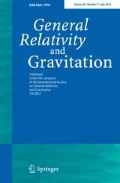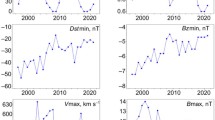Abstract
In this paper we explore the possibility of suitably combining the nodes Ω of the existing geodetic LAGEOS, LAGEOS II and Ajisai laser-ranged satellites and of the radar altimeter Jason–1 satellite in order to increase the accuracy in testing the general relativistic gravitomagnetic Lense–Thirring secular effect in the gravitational field of the Earth. The proposal of introducing Ajisai and Jason–1 in such a combination comes from the expected benefits which could be obtained in reducing the aliasing secular impact of the classical part of the terrestrial gravitational field. According to the recently released EIGEN-CG01C combined GRACE + CHAMP + terrestrial gravimetry/altimetry Earth gravity model, the impact of the static part of the mismodelled even zonal harmonics of geopotential, which represent the major source of systematic error, amounts to 1.6%, at 1−σ level. It is better than the error which could be obtained with a two-node LAGEOS-LAGEOS II only combination (6% at 1−σ). Moreover, the proposed combination would be insensitive also to the secular variations of the low-degree even zonal harmonics, contrary to the LAGEOS-LAGEOS II only combination. Such variations could be a serious limiting factor over observational time spans many years long. The price to be paid for this improvements of the systematic error of gravitational origin is represented by the non-conservative forces introduced along with the new orbital elements. However, they would induce periodic perturbations, contrary to the gravitational noise. A major concern would be the assessment of the impact of the non-conservative accelerations on the Jason–1 node. According to the present-day force models, the mismodelling in the non-conservative forces would, at worst, induce an aliasing periodic signal with an amplitude of 4% of the Lense-Thirring effect over a time span of 2 years. However, an observational time span of just some years could safely be adopted in order to fit and remove the residual long–period non-gravitational signals affecting Jason’s node, which, in the case of the direct solar radiation pressure, have a main periodicity of approximately 120 days. Of course, the possibility of getting time series of the Jason’s node some years long should be demonstrated in reality.
Similar content being viewed by others
References
Ciufolini, I., Wheeler, J.A.: Gravitation and Inertia. Princeton University Press, New York (1995)
Stella, L., et al.: Section E probing the gravitomagnetic Lense-Thirring effect with neutron stars and black holes. In: Ruffini, R., Sigismondi, C. (eds.) Nonlinear Gravitodynamics. The Lense–Thirring Effect, World Scientific, Singapore, pp. 235–345 (2003)
Nordtvedt, K.: Some considerations on the varieties of frame dragging. In: Ruffini, R., Sigismondi, C. (eds.) Nonlinear Gravitodynamics. The Lense–Thirring Effect, World Scientific, Singapore, pp. 35–45 (2003)
Schiff, L.I.: On experimental tests of the general theory of relativity. Am. J. Phys. 28, 340–343 (1960)
Everitt, C.W.F.: And other members of the gravity probe B team. In: Lämmerzahl, C., Everitt, C.W.F., Hehl, F.W. (eds.) Gyros, Clocks, Interferometers...: Testing Relativistic Gravity in Space. (Lecture Note in Physics 562), pp. 52–82. Springer, Berlin (2001)
Lense, J., Thirring, H.: Über den Einfluss der Eigenrotation der Zentralkörper auf die Bewegung der Planeten und Monde nach der Einsteinschen Gravitationstheorie Phys. Z. 19, 156–163; translated and discussed by Mashhoon, B., Hehl, F.W., Theiss, D.S. (1918). On the gravitational effects of rotating masses: The Thirring-Lense papers. Gen. Rel. Grav. 16, 711–750 (1984)
Ciufolini, I.: Measurement of Lense–Thirring drag on high-altitude laser ranged artificial satellite. Phys. Rev. Lett. 56, 278–281 (1986)
Iorio, L., Lucchesi, D., Ciufolini, I.: The LARES mission revisited: an alternative scenario. Class. Quantum. Grav. 19, 4311–4325 (2002)
Iorio, L., Ciufolini, I., Pavlis, E.C., Schiller, S., Dittus, H., Lämmerzahl, C.: On the possibility of measuring the Lense-Thirring effect with a LAGEOS-LAGEOS II-OPTIS mission. Class. Quantum. Grav. 21, 2139–2151 (2004)
Lämmerzahl, C., Dittus, H., Peters, A., Schiller, S.: OPTIS–a satellite–based test of special and general relativity. Class. Quantum. Grav. 18, 2499–2508 (2001)
Ciufolini, I., Pavlis, E.C., Chieppa, F., Fernandes-Vieira, E., Pérez-Mercader, J.: Test of general relativity and measurement of the Lense-Thirring effect with two earth satellites. Science 279, 2100–2103 (1998)
Ciufolini, I.: Test of general relativity: 1995–2002 measurement of frame–dragging. In: Proceedings of the Physics in Collision Conference. Stanford, California, June 20–22 Preprint (2002) [gr-qc/0209109]
Ciufolini, I.: On a new method to measure the gravitomagnetic field using two orbiting satellites. Il Nuovo Cimento A 109, 1709–1720 (1996)
Will, C.M.: Theory and Experiment in Gravitational Physics, 2nd edition. Cambridge University Press, Cambridge, United Kingdom (1993)
Will, C.M.: http://www.livingreviews.org/Articles/Volume4/2001-4will (2001)
Ries, J.C., Eanes, R.J., Tapley, B.D., Peterson, G.E.: Prospects for an improved Lense-Thirring test with SLR and the GRACE gravity mission. In: Noomen, R., Klosko, S., Noll, C., Pearlman, M. (eds.) Proc. 13th Int. Laser Ranging Workshop NASA CP 2003-212248 (NASA Goddard) (2003). (Preprint http://cddisa.gsfc.nasa.gov/lw13/lw_proceedings.html#science)
Ries, J.C., Eanes, R.J., Tapley, B.D.: Lense-Thirring precession determination from laser ranging to artificial satellites. In: Ruffini, R., Sigismondi, C. (eds.) Nonlinear Gravitodynamics. The Lense–Thirring effect. World Scientific, Singapore, pp. 201–211 (2003)
Lemoine, F.G., Kenyon, S.C., Factor, J.K., Trimmer, R.G., Pavlis, N.K., Chinn, D.S., Cox, C.M., Klosko, S.M., Luthcke, S.B., Torrence, M.H., Wang, Y.M., Williamson, R.G., Pavlis, E.C., Rapp, R.H., Olson, T.R.: The development of the joint NASA GSFC and the National Imagery Mapping Agency (NIMA) Geopotential Model EGM96 NASA/TP-1998-206861 (1998)
Iorio, L.: The impact of the static part of the Earth’s gravity field on some tests of general relativity with satellite laser ranging. Celest. Mech. & Dyn. Astron. 86, 277–294 (2003)
Iorio, L. Morea, A.: The impact of the new earth gravity models on the measurement of the Lense–Thirring effect. Gen. Rel. Grav. 36, 1321–1333 (2004)
Lucchesi, D.: Reassessment of the error modelling of non-gravitational perturbations on LAGEOS II and their impact in the Lense-Thirring determination. Part I, Planet. Space Sci. 49, 447–463 (2001)
Lucchesi, D.: Reassessment of the error modelling of non-gravitational perturbations on LAGEOS II and their impact in the Lense–Thirring determination. Part II Planet. Space Sci. 50, 1067–1100 (2002)
Pavlis, E.C.: Geodetic contributions to gravitational experiments in space. In: Cianci, R., Collina, R., Francaviglia, M., Fré, P. (eds.) Recent Developments in General Relativity, pp. 217–233. Springer–Verlag, Milan (2002)
Iorio, L.: Is it possible to improve the present LAGEOS–LAGEOS II Lense–Thirring experiment? Class. and Quantum Grav. 19, 5473–5480 (2002)
Reigber, Ch., Schwintzer, P., Stubenvoll, R., Schmidt, R., Flechtner, F., Meyer, U., König, R., Neumayer, H., Förste, Ch., Barthelmes, F., Zhu, S.Y., Balmino, G., Biancale, R., Lemoine, J.-M., Meixner, H., Raimondo, J.C.: A high resolution global gravity field model combining champ and grace satellite mission and surface gravity data: EIGEN-CG01C. Submitted to J. Geod. (2004)
Iorio, L.: Earth tides and Lense-Thirring effect. Celest. Mech. & Dyn. Astron. 79, 201–230 (2001)
Cox, C., Au, A., Boy, J.-P., Chao, B.: Time variable gravity: using satellite laser ranging as a tool for observing long-term changes in the earth system. In: Proceedings of the 13th International Laser Ranging Workshop, Washington DC, October 7–11 Preprint http://cddisa.gsfc.nasa.gov/lw13/lw_proceedings.html#science (2002)
Ciufolini, I., Pavlis, E.C.: A confirmation of the general relativistic prediction of the Lense-Thirring effect. Nature 431, 958–960 (2004)
Reigber, Ch., Schmidt, R., Flechtner, F., König, R., Meyer, U., Neumayer, K.-H., Schwintzer, P., Zhu, S.Y.: An earth gravity field model complete to degree and order 150 from GRACE: EIGEN-GRACE02S. J. Geodynamics 39, 1–10 (2005)
Iorio, L.: On the reliability of the so far performed tests for measuring the Lense-Thirring effect with the LAGEOS satellites. New Astronomy 10, 603–615 (2005a) doi: 10.1016/j.newast.2005.01.001.; Iorio, L.: The impact of the new Earth gravity models on the measurement of the Lense-Thirring effect with a new satellite. New Astronomy 10, 632–651 (2005b) doi: 10.1016/j.newast.2005.02.006
Luthcke, S.B., Zelensky, N.P., Rowlands, D.D., Lemoine, F.G., Williams, T.A.: The 1–centimeter orbit: jason–1 precision orbit determination using gps, SLR, DORIS, and Altimeter Data. Marine Geod. 26, 399–421 (2003)
Vespe, F., Rutigliano, P.: The improvement of the Earth gravity field estimation and its benefits in the atmosphere and fundamental physics. Paper presented at 35th COSPAR Scientific Assembly Paris, France, 18–25 July 2004, COSPAR04-A-03614 Adv. Sp. Res., submitted (2004)
Tapley, B.D., Watkins, M.M., Ries, J.C., Davies, G.W., Eanes, R.J., Poole, S.R., Rim, H.J., Schutz, B.E., Shum, C.K., Nerem, R.S., Lerch, F.J., Marshall, J.A., Klosko, S.M., Pavlis, N.K., Williamson, R.G.: The joint gravity model 3. J. Geophys. Res. 101, 28029–28049 (1996)
Iorio, L., Pavlis, E.C.: Tidal satellite perturbations and the Lense-Thirring effect. J. Geod. Soc. of Japan 47, 169–173 (2001)
Pavlis, E.C., Iorio, L.: The impact of tidal errors on the determination of the Lense-Thirring effect from satellite laser ranging. Int. J. Mod. Phys. D 11, 599–618 (2002)
Abd El-Salam, F.A., Sehnal, L.: A second order analytical atmospheric drag theory based on the TD88 thermospheric density model. Celst. Mech. & Dyn. Astron. 90, 361–389 (2004)
Sengoku, A., Cheng, M.K., Schutz, B.E., Hashimoto, H.: Earth–heating effect on Ajisai. J. Geod. Soc. of Japan 42, 15–27 (1996)
Sengoku, A., Cheng, M.K., Schutz, B.E.: Anisotropic reflection effect on satellite Ajisai. J. Geod. 70, 140–145 (1995)
Marshall, J.A., Zelensky, N.P., Klosko, S.M., Chinn, D.S., Luthcke, S.B., Rachlin, K.E., Williamson, R.G.: The temporal and spatial characteristics of TOPEX/Poseidon radial orbit error. J. Geophys. Res. 100, 25331–25352 (1995)
Antreasian, P.G., Rosborough G.W.: Prediction of radiant energy forces on the TOPEX/Poseidon spacecraft. J. Spacecraft Rockets 29, 81–90 (1992)
Marshall, J.A., Luthcke, S.B.: Radiative force model performance for TOPEX/Poseidon precision orbit determination. J. Astronaut. Sci. 49, 229–246 (1994)
Kubitschek, D.G., Born, G.H.: Modelling the anomalous acceleration and radiation pressure forces for the TOPEX/POSEIDON spacecraft. Phil. Trans. R. Soc. Lond. A 359, 2191–2208 (2001)
Berthias, J.-P., Piuzzi, A., Ferrier, C.: Jason postlaunch satellite characteristics for POD activities. http://calval.jason.oceanobs.com/html/calval_plan/pod/modele_jason.html (2002)
Doornbos, E., Scharroo, R., Klinkrad, H., Zandbergen, R., Fritsche, B.: Improved modelling of surface forces in the orbit determination of ERS and Envisat. Can. J. Remote Sensing 28, 535–543 (2002)
Ziebart, M., Adhya, S., Cross, P., Bar–Sever, Y., Desai, S.: Pixel array solar and thermal force modelling for Jason: On–orbit test results paper presented at the ‘From TOPEX-POSEIDON to Jason’ Science Working Team meeting. Arles, France (2003)
Author information
Authors and Affiliations
Corresponding author
Rights and permissions
About this article
Cite this article
Iorio, L., Doornbos, E. How to reach a few percent level in determining the Lense–Thirring effect?. Gen Relativ Gravit 37, 1059–1074 (2005). https://doi.org/10.1007/s10714-005-0091-2
Received:
Revised:
Published:
Issue Date:
DOI: https://doi.org/10.1007/s10714-005-0091-2




